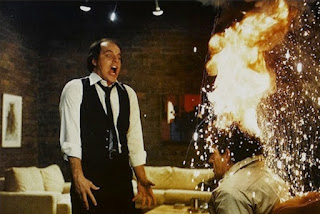Monday, October 31, 2022
13 Nights of Shocktober: Hocus Pocus
Sunday, October 30, 2022
13 Nights of Shocktober: Tales of Terror
Saturday, October 29, 2022
13 Nights of Shocktober: From Beyond (1986)
Friday, October 28, 2022
13 Nights of Shocktober: My Best Friend's Exorcism
Thursday, October 27, 2022
13 Nights of Shocktober: Peeping Tom
Wednesday, October 26, 2022
13 Nights of Shocktober: Dr. Jekyll and Mr. Hyde (1931)
Tuesday, October 25, 2022
13 Nights of Shocktober: Scanners
This is my favorite time of year, second only to Christmas. Autumn has arrived, the weather is cooling down, and October becomes the month-long celebration of scary movies called Shocktober. So, for the days leading up Halloween I’ll be posting some horror movie recommendations to help you celebrate Shocktober.
Night 7: Cronenberg Night
We're gonna do this the scanner way.
“You’re a scanner but you don’t realize it,” the main character of Scanners is told about six minutes into the film. Writer-director David Cronenberg wastes no time in getting to the plot and action of his 1981 sci-fi horror thriller. Wasting no time may as well be the mantra of Scanners, which is famous for being the movie where someone’s head explodes in the first 10 minutes (it actually happens around 13 minutes into the movie). I don’t want to give the impression that Scanners is some sort of adrenaline filled special effects geek show. This is a well-paced thriller that combines science-fiction, action, and, of course, body horror that also manages to be a surprisingly believable story about warring groups of psychics.
Cameron Vale (Stephen Lack), a drifter suffering from constantly hearing voices, awakes in a strange room and is told by Dr. Ruth (Patrick McGoohan) that he is a scanner, a person able to connect with and affect others by means of telepathy. Dr. Ruth works for an organization called Consec that recruits scanners and develops a serum that suppresses the constant barrage of voices. It is unclear whether Consec is a private company or government organization, but it certainly has secrets and shady members. Dr. Ruth trains Vale to harness his ability to use against Daryll Revok (Michael Ironside), a rogue scanner out to build a scanner army and dominate non-scanning humans. Revok kills all scanners who will not join.
At a public but sparsely attended demonstration a scanner attempts to demonstrate proof of his telepathy by scanning people from the audience. Unfortunately, the volunteer is Revok, who, in one of the most famous moments in modern horror film history, makes the other scanner’s head explode. The exploding effect is done in full light in a single shot and in close up. Even if you’ve never seen the movie, you’ve likely seen this moment as a meme or gif around the internet to demonstrate that something is “mindblowing”. Yes, it is graphic and gross, but honestly, I think most viewers would be too in shock by what they’ve just seen to be grossed out. In a nice touch there is a reaction shot of Revok and even he is shocked by what just happened. It manages to catch me off guard at each viewing. In any case, there is nothing else like that in the movie, so if you can make it past that scene the rest of the violence is tame by comparison. On the other hand, if you are looking for a movie filled with impressive practical visual and make-up effects, you’ll probably be disappointed and should check out Cronenberg’s version of The Fly.













































